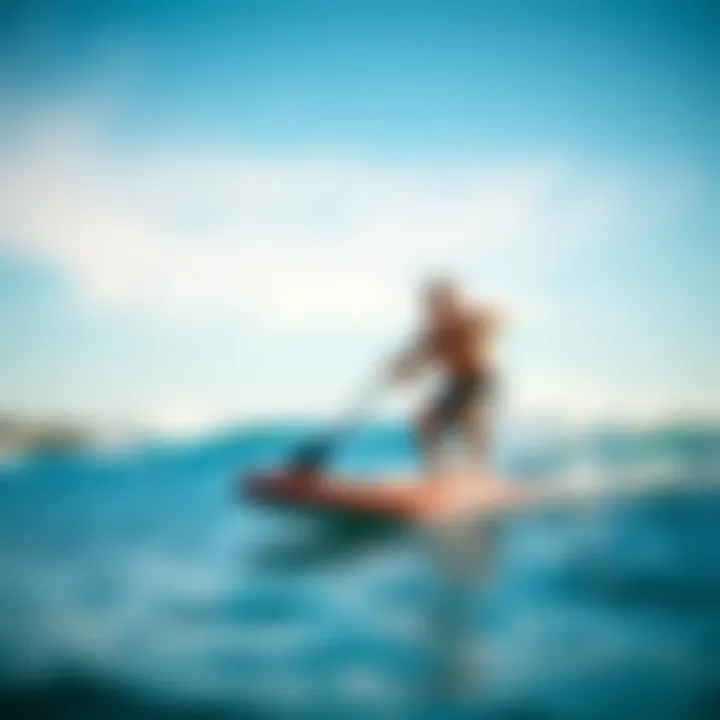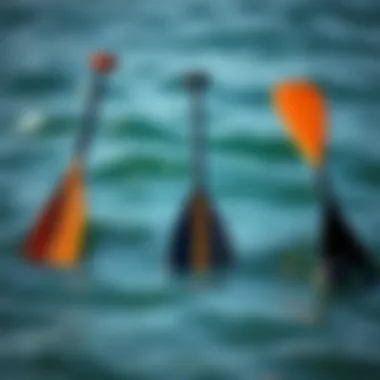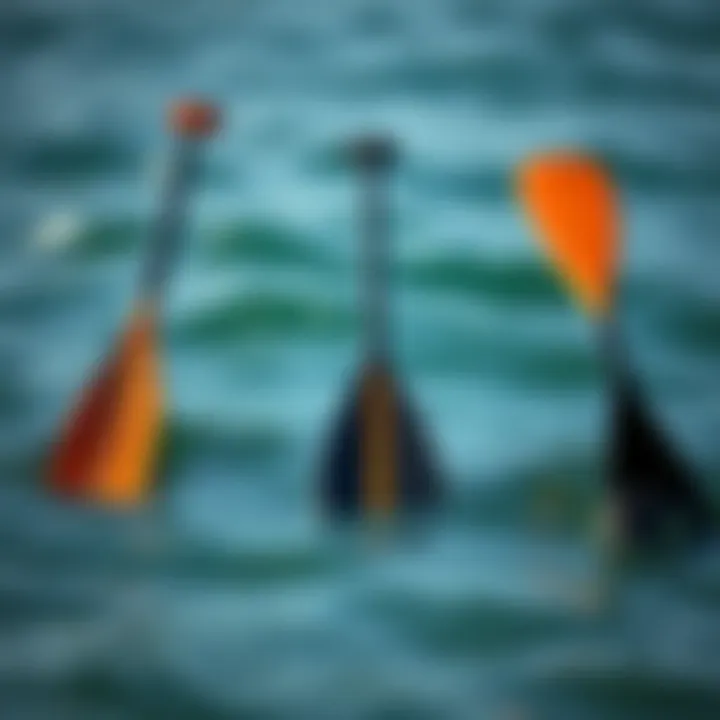Mastering Stand Up Paddle Board Paddling Essentials


Intro
Stand-up paddle boarding (SUP) offers a unique blend of relaxation and physical activity. It’s not just about gliding across the water; it’s an experience that connects individuals to nature while providing a full-body workout. Getting the most out of this pastime requires a thorough understanding of paddles, a crucial element in shaping your time on the water.
From a broad perspective, the paddle serves as an extension of oneself. Choosing the right paddle can dramatically transform one’s experience, allowing for better maneuverability, efficiency, and enjoyment. Whether you're a newcomer wading into the SUP waters or an experienced paddler seeking to refine your technique, grasping the essentials of paddling is instrumental to your success.
In the sections below, we will explore various facets of stand-up paddle performance, encompassing gear and equipment, essential techniques, and some maintenance tips to keep your paddle in top-notch condition. This guide aims to provide valuable insights and equip you with the necessary knowledge for embarking on your paddle boarding adventures with confidence.
Gear and Equipment
Understanding the right gear is pivotal for enhancing both safety and performance on the water. Paddles come in different types and are designed with specific features tailored to distinct paddling situations.
Paddle Designs and Materials
The composition of your paddle can make a world of difference. Most paddles are made from materials such as plastic, fiberglass, and carbon fiber. Here’s a summary of these materials:
- Plastic: Often the most affordable choice. While it can be heavier, it’s quite durable and suitable for beginners.
- Fiberglass: Offers a balance between weight and performance. This choice is popular among intermediate paddlers who seek enhanced performance without breaking the bank.
- Carbon Fiber: The lightest and most sophisticated option, providing high-efficiency paddling. However, it comes at a premium price, generally favored by advanced paddlers.
Paddle Length
Choosing the right length of paddle is as crucial as selecting the right material. A common formula to determine an appropriate paddle length is:
- Add 6 to 8 inches to your height for recreational use.
- For racing or heavy performance, consider adding 8 to 10 inches.
Selecting a paddle length helps in maintaining a comfortable stance while maximizing energy expenditure on long paddles.
"The paddle, though seemingly mundane, is like a magic wand; it allows you to navigate, dance, and explore the waterways like they were your own backyard."
Essential Accessories for Every Paddler
When outfitting yourself for paddleboarding, various accessories can enhance your experience:
- Leash: Perhaps the most overlooked accessory, a leash can keep your board from drifting away if you fall off. It’s a simple safety measure that every paddler should invest in.
- Personal Floatation Device (PFD): Mandatory in many waters, a PFD ensures safety. Always choose one that permits free movement while paddling.
- Dry Bag: A waterproof bag safeguards your valuables, allowing you to enjoy your time on the water without worry about your belongings.
Surf Techniques and Skills
Ultimately, paddle techniques can greatly affect your performance. Whether you're maneuvering through choppy waters or gliding across calm lakes, mastering your technique is key.
Beginner Techniques
For those just starting, focus on these foundational techniques:
- Forward Stroke: Stand with feet shoulder-width apart, engage your core, and pull the paddle back while keeping it vertical. Rotate your torso for maximum power.
- Turning: Use the sweep stroke, which entails moving the paddle in a wide arc parallel to the board's side to steer.
Advanced Maneuvers
Once you have a handle on the basics, you may want to delve into more complex maneuvers, such as:
- Cross-Bow Turn: A more agile turn, where you reach across the board to paddle on the opposite side. It’s useful in tight situations or when you need to pivot quickly.
- Draw Stroke: This technique allows you to pull your board sideways by using the paddle to make contact with the water in-line with your board. It's handy for avoiding obstacles or maneuvering in narrow spaces.
Understanding the essentials of stand-up paddle board paddling isn't just about learning how to paddle. It's about fostering a relationship with your equipment, honing your skills, and ensuring safety while engaging in one of the most fulfilling water sports. By equipping yourself with the right tools and techniques, you're setting yourself up for countless rewarding paddling adventures.
Prelims to Stand Up Paddle Boarding
Stand up paddle boarding (SUP) has made quite the splash in recent years, captivating water lovers and outdoor enthusiasts alike. But what exactly makes this sport so appealing? SUP offers an accessible way to engage with water, allowing people of all ages and skill levels to enjoy the great outdoors. From tranquil lakes to radiant coastlines, this activity opens the door to stunning experiences that blend recreation and fitness.
Understanding the intricacies of paddle boarding is crucial, as it not only enhances your skills but also enriches your connection with nature. In this article, we will dive into the various components of this engaging pursuit, with a strong focus on paddles—the heart and soul of the activity. A paddle acts as an extension of your body, and its design, material, and length can dramatically affect performance and enjoyment on the water.
The Evolution of Paddle Boarding
The roots of paddle boarding trace back centuries to ancient Polynesian cultures, where the concept of standing on a board and propelling oneself with a paddle was born out of necessity and practicality. However, the modern rise of paddle boarding took off in the early 2000s, thanks mostly to improved materials and enthusiastic communities sharing the sport online. Brands like Naish and Starboard sprang up, creating boards that catered to this newly invigorated interest, and today, you can find countless variations of boards tailored for different styles, from racing to yoga.
It’s fascinating how paddle boarding has transitioned from a traditional soulful experience to one peppered with innovation and diversity. Experienced paddlers now find themselves exploring remote destinations, with some even taking their boards on multi-day adventures—definitely no snooze-fest!
Core Elements of Paddle Boarding
To truly grasp the essence of stand-up paddle boarding, you need to consider a few core elements. Firstly, balance plays a monumental role. Whether you’re gliding on calm waters or navigating choppy waves, maintaining your center of gravity keeps you upright. Secondly, the technique of paddling itself is vital. Effective paddle strokes not only advance you forward but also help with steering and maneuvering.
Additionally, understanding environmental factors such as wind and current cannot be overstated. Being aware of how these elements can impact your paddling can significantly improve your experience.
To sum up, the journey into the world of paddle boarding is rich with tradition and ripe with opportunities for personal growth. By familiarizing yourself with the evolution of the sport and its core components, you’re setting the stage for a rewarding experience on the water. Once you have a handle on the essentials, the adventure is truly endless.


The Role of the Paddle
The paddle is not just an accessory in stand-up paddle boarding; it's the heartbeat of your experience on the water. Understanding its role equips both beginners and seasoned paddlers with insights that can transform their time spent on the water. This section delves into why the paddle is crucial, its various forms, and how it impacts your overall performance.
Paddle as a Primary Tool
When you think about it, without a paddle, you'd be left floundering on your board, quite literally. The paddle serves as the primary tool that connects you to the water. Much like a sailor relies on a rudder, a paddle gives you direction, pace, and power.
Significance of Choosing the Right Paddle
- Material Matters: Paddles come in different materials like aluminum, fiberglass, and carbon fiber. Each type offers unique benefits—lightweight materials allow for longer paddling sessions with reduced fatigue, while heavier materials can provide a more sturdy feel.
- Length Variation: Depending on your height and paddling style, the length of the paddle plays a significant role. A paddle that’s too long can become unwieldy, while one that's too short may not allow for efficient stroke mechanics.
- Grip Comfort: Focusing on the grip is vital. A comfortable grip allows for longer sessions without cramping or discomfort, making it easier for you to enjoy your time on the water.
Impact on Performance
Your paddle's design and construction can significantly affect how well you perform on the water. It doesn’t just help you move; it enhances your entire paddling experience.
Efficiency and Technique
The paddle influences how efficiently you glide across the water. A well-designed paddle enables smoother strokes and reduces the effort required, which is crucial during long-distance paddling. A clean stroke reduces splashing and allows you to stay in tune with the natural rhythm of the water.
Maneuverability
Your paddle's characteristics also dictate how easily you can maneuver your board. More agile paddles allow for quicker responses in changing conditions, while a longer or more rigid paddle might be better suited for stability but less for rapid movements.
Using the right paddle isn’t merely about choosing a tool; it’s about enhancing your relationship with the water.
Epilogue on the Paddle's Role
Ultimately, the paddle plays a central role in both the enjoyment and execution of stand-up paddle boarding. Beyond its functional purpose, it becomes an extension of you, aiding exploration, challenging your skills, and contributing to your connection with nature. Choosing the right paddle is not trivial; it’s a foundational decision that will affect everything from your technique to your endurance on the water.
Types of Stand Up Paddle Board Paddles
Understanding the different types of stand up paddle board paddles is crucial for anyone looking to enhance their experience on the water. Selecting the right paddle goes beyond just aesthetics; it directly impacts paddling efficiency, comfort, and overall performance. With a myriad of options available, each designed to address specific needs or preferences, knowing what’s out there can set you apart from the crowd, ensuring you’re equipped to navigate various water conditions smoothly.
Material Variations
Aluminum Paddles
Aluminum paddles are often seen as an entry-level choice. They are known for their durability, making them perfect for those who might not have mastered the art of paddle boarding yet. One of the significant characteristics of aluminum paddles is their affordability. This cost-effectiveness makes them a popular option among newcomers. However, while they are sturdy, they can be heavier compared to paddles made from other materials. This weight can lead to fatigue over longer paddling sessions.
A unique feature of aluminum paddles is the potential for adjustable lengths. This allows users to find the perfect height suited to their stature. But beware—if not properly cared for, aluminum can corrode when exposed to saltwater, which could shorten its lifespan.
Carbon Fiber Paddles
For those who seek performance, carbon fiber paddles steal the show. They are lighter and stiffer than their aluminum counterparts, allowing for more efficient strokes. Many experienced paddle boarders opt for this material for its superior strength-to-weight ratio. This means you can paddle longer distances with less fatigue.
The standout feature of carbon fiber paddles is their responsiveness; the paddle translates your strokes into speed and power seamlessly. They also boast enhanced buoyancy, making them easier to handle on the water. However, this quality comes at a price—carbon fiber paddles tend to be on the pricier side. If budget isn't an issue and you seek performance, these paddles are undeniably a smart investment.
Fiberglass Paddles
Fiberglass paddles are touted for their balance between weight and cost. They tend to be lighter than aluminum but heavier than carbon fiber. This blend provides a nice compromise for folks who are serious about their paddle boarding but may not want to go all in on a carbon fiber paddle just yet.
The unique selling point of fiberglass is its smooth and efficient paddling experience. When you glide through the water with a fiberglass paddle, you might notice the difference; they help maintain momentum effectively. On the flip side, they might not hold up as well against wear and tear as carbon fiber does, especially if you frequently paddle in rocky or challenging environments.
Different Paddle Shapes
Straight Shaft Paddles
Straight shaft paddles are what you might call the classic design. They are straightforward and tend to be quite versatile, suitable for various paddling styles. One advantageous trait is their simplicity, which can be appealing for beginners. The straight shaft provides a comfortable grip and natural paddling motion.
However, some paddlers might find that a straight shaft paddle doesn’t provide the same type of leverage as other designs. In essence, it can feel a bit less efficient during long paddles.
Bent Shaft Paddles
Bent shaft paddles, with their angle in the shaft, offer a different approach. This bending allows for a more efficient stroke, especially handy for those looking to paddle efficiently over long distances or through tight spots. Many find this angle helps reduce wrist strain, making them a go-to for extended paddle sessions.
The downside is that not everyone finds bent shafts comfortable. It’s crucial to test it out personally to see if it suits your style. If you find it works for you, though, it can elevate your paddling to a new level.
Adjustable Paddles
Adjustable paddles have become increasingly popular among diverse paddling groups. As with aluminum paddles, these offer the flexibility to adapt their length, making them a versatile choice for individuals of varying heights or for those sharing a paddle. This is particularly helpful in group settings or families where different users might have different preferences.
The main advantage lies in their adaptability, allowing users to switch lengths depending on the paddling environment or personal comfort. But they can sometimes be more expensive than a fixed paddle, and if not locked properly, there's a risk of the shaft slipping during use, which can disrupt your paddling rhythm.


Picking the right paddle isn't just a choice; it’s the beginning of mastering your paddle board experience. Understanding material and shape can help you select the paddle that feels just right for your adventures.
Selecting the Right Paddle
Selecting a paddle isn’t just about grabbing whatever comes in sight. It’s about finding the right fit for your paddling needs and goals. A well-chosen paddle can amplify your performance on the water, making the difference between cruising effortlessly and flailing like a fish out of water. Let’s explore some critical components that you need to think about when making that choice.
Determining Paddle Length
Choosing the correct paddle length is akin to finding the perfect pair of shoes. If it’s too short, you might be bending down, straining your back; too long, and you’re wasting energy stretching too far. Here are some guidelines to help you get it right:
- Height Matters: A good rule of thumb is to add 8 to 10 inches to your height. This works well for most paddlers.
- Board Width Impact: Wider boards might necessitate a longer paddle to maintain a comfortable stroke length.
- Usage Style: For racing or high-performance paddling, you might prefer a longer paddle for more powerful strokes.
Ultimately, every paddler has a unique preference based on their style and conditions. Testing a few different lengths before committing to one can guide you in the right direction.
Considerations for Skill Level
Your skill level also plays a significant role in the selection process. Different paddles can cater to diferentes abilities:
- Beginners: It’s best to start with a paddle that offers a little more buoyancy and stability. Look for adjustable paddles that can grow with you as you refine your skills.
- Intermediate Paddlers: At this stage, you may want a paddle that balances performance with comfort. A lightweight design can enhance your efficiency without sacrificing control.
- Advanced Users: Experienced paddlers often choose specialized paddles tailored to their specific needs, such as touring or racing styles.
Getting the right paddle can also help improve your technique. If you’re struggling with a paddle that doesn’t suit your skill level, it can hinder your progression. Therefore, investing time in understanding what fits your current ability can be a game changer.
Selecting a paddle isn’t just a technicality; it profoundly influences your enjoyment and performance on the water.
In summary, choosing the right paddle is a multifaceted process, revolving around not only your height and board width but your skill level as well. Taking the time to evaluate these factors can lead you to a paddle that feels like an extension of your arm, enhancing both your experience and performance in paddle boarding.
Techniques for Effective Paddle Use
Using a stand-up paddle board is not just about gliding across the water. The methods we employ while paddling can greatly enhance our experience on the board. To get the most out of this aquatic activity, mastering effective paddle use techniques is essential. These techniques focus on optimizing our strokes, movements, and overall performance on the water.
When done correctly, efficient paddling can improve speed, stability, and turning capabilities, which leads to a better overall experience. Learning the different strokes and maneuvers allows paddlers to adapt to various conditions, whether you're navigating calm lakes or tackling choppy ocean waves. This section will illuminate some basic and advanced techniques that can elevate your paddle boarding skills.
Basic Strokes and Movements
Basic strokes form the backbone of an enjoyable paddle boarding experience. Knowing how to hold the paddle and execute a proper stroke is crucial. The catch, pull, and exit phases of the stroke work together to propel the paddle board forward smoothly.
- The Catch: This is the entry point where the paddle goes into the water. It should be done gently to ensure minimal splash, allowing you to conserve energy.
- The Pull: This phase is where the power lies. By using your core muscles rather than just your arms, you can generate more propulsion. It’s key to pull the paddle straight back alongside the board to maximize efficiency.
- The Exit: As your paddle leaves the water, don’t yank it out abruptly. Instead, exit the paddle smoothly to maintain balance and avoid losing momentum.
Getting these strokes down pat will help you maneuver with confidence on the water.
Advanced Techniques for Maneuverability
As you become familiar with the basics, it’s time to dive deeper into advanced techniques that offer significant benefits.
Turning Techniques
Turning techniques are crucial when you're navigating tight spaces or wanting to change direction quickly. The ability to turn smoothly can mean the difference between an enjoyable outing and a frustrating experience.
One popular method involves a compound stroke, where one paddle stroke pushes you forward while the opposite paddle stays in the water at an angle. This technique aids in pivoting the board effectively.
- Key Characteristic: This technique utilizes lateral weight shifts and the paddle’s position for a controlled turn.
- Advantages: It allows for quick direction changes, making it quite popular among paddlers who enjoy exploring rugged coastlines or winding rivers.
- Disadvantages: It requires practice. Those unfamiliar may struggle with the timing.
"Mastering turning techniques can transform your paddle boarding experience, making navigation feel effortless."
Stability Enhancements
Stability on a paddle board is vital, especially for beginners or those venturing into rougher waters. Stability enhancements focus on adjusting your stance, paddle placement, and even utilizing specific strokes that contribute to a steadier ride.
One method involves lowering your center of gravity by bending your knees slightly while paddling. This change helps in balancing out the board in choppy water.
- Key Characteristic: An adjusted posture coupled with effective strokes improves control and minimizes the chance of tipping.
- Advantages: This technique allows for tackling more challenging conditions without sacrificing confidence.
- Disadvantages: It might feel uncomfortable at first, necessitating a period of adjustment for new paddlers.
Learning these advanced techniques not only broadens your skill set but also enhances your confidence and enjoyment while paddle boarding. With practice, these methods will feel like second nature, and soon enough, you’ll be gliding across the water with finesse.
Maintenance and Care of Your Paddle
Taking proper care of your stand up paddle board paddle is not just about keeping it pretty; it’s about enhancing its longevity and ensuring you have a smooth ride every time you hit the water. A well-maintained paddle performs better, feels more comfortable during use, and can ultimately save you from costly replacements. By giving your paddle a little TLC, you enhance your overall paddling experience. Let’s dive into why this is crucial and how to effectively look after your paddle.
Checking for Damage
Regardless of how good a paddle looks on the outside, it’s what’s beneath the surface that can spell trouble. Damage can often be subtle, like hairline cracks or minor dings that can lead to bigger issues over time. Regularly inspect your paddle for any signs of wear and tear:
- Visual Inspection: Look for cracks or chips in the blade. A small scratch might not seem like a big deal, but it can affect your glide and efficiency on the water.
- Flex Test: Gently bend the shaft; if it feels brittle or has unusual flex, it could be time for a replacement.
- Water Leakage: If your paddle has hollow sections and you notice water inside, you’ll want to address that ASAP. The added weight will slow you down and cause more damage in the long run.


Taking a few moments after each trip to check for damage can save you headaches later. Remember, an ounce of prevention is worth a pound of cure.
Cleaning and Storage Tips
The condition of your paddle depends heavily on how you clean and store it. Here are some proactive measures:
- Rinse After Use: Whenever you paddle in salty or brackish water, always rinse your paddle with fresh water as soon as you can. Salt and sand can corrode and wear down materials.
- Mild Detergent: For a deeper clean, use a mild detergent and soft sponge to wipe down the paddle. Avoid abrasive cleaners that can scratch the surface.
- Drying: Always dry your paddle thoroughly before storage. Storing it while damp can encourage mildew and mold, especially if you’re stashing it away for the winter.
- Optimal Storage: Hang it or keep it in a cool, dry place, away from direct sunlight. Sun exposure can fade colors and weaken materials over time.
In addition to these practices, investing in a proper paddle bag can help protect your gear when transporting. It adds an extra layer against bumps and drops that may occur during your travels.
Remember: "A clean paddle is a happy paddle!"
By adopting regular maintenance routines, you’ll not only extend the life of your paddle but also ensure that you're ready to take on any adventure on the water. Ergonomic paddling can only get you so far if you're working with a tool that’s not up to snuff. So, treat your paddle right and it will treat you right back.
Accessories Related to Paddles
When it comes to stand up paddle boarding, having the right accessories can make a world of difference in your experience. While most enthusiasts focus on selecting the right board and paddle, accessories related to paddles are equally important. These accessories not only enhance safety and convenience but also improve your performance on the water. Whether you’re a seasoned paddler or a newbie, understanding these accessories ensures you’re better prepared for any adventure.
Paddle Leashes
Paddle leashes are an often-overlooked but essential accessory for paddle boarders. These ropes attach your paddle to the board, ensuring it doesn’t float away if you drop it. Losing a paddle can put a real damper on your day, especially in open waters! Moreover, maintaining a paddle leash can enhance safety, particularly in unpredictable conditions or over big waves.
But it’s not just about safety; paddle leashes can also improve your overall paddling experience. With a leash on, you won’t constantly look over your shoulder if you accidentally let go of your paddle. Instead, you can focus fully on your stroke and navigating the waters.
Types of Paddle Leashes:
- Coiled Leashes: These are fantastic for flat waters and allow for full range while keeping the paddle close.
- Straight Leashes: Ideal for surfing, as they don’t interfere much with your movements.
In short, opting for a proper paddle leash is a decision that pays off. They provide peace of mind, allowing you to paddle without the nagging worry of losing your gear.
Paddle Bag Options
Paddle bags are another crucial accessory, serving a dual purpose: protection and convenience. When transporting your paddle, whether it's to a serene lake or along the coast, a paddle bag keeps it safe from scratches and dings. A well-padded bag can drastically extend the lifespan of your paddle by providing a soft barrier against accidental bumps.
When selecting a paddle bag, consider the following:
- Sizing: Not all paddles are created equal. Ensure your bag fits snugly, allowing for easy transport.
- Material: Look for durable materials that can withstand the elements, especially if you’re often on the road.
- Additional Compartments: Some bags offer extra pockets for your paddle leashes or personal items, adding convenience for a day on the water.
Having the right paddle bag means you’ll be less likely to show up to your intended paddling destination with a chipped or damaged paddle. It's about preserving your gear, and that bit of extra protection can make a substantial difference.
"A good paddle bag is like a well-made suitcase; it keeps everything in its place and is ready for adventure."
The Paddle Boarding Experience
The world of stand-up paddle boarding encompasses more than just a vessel to glide over water. The paddle boarding experience encapsulates a deeper connection between the paddler, the water, and the surrounding environment. Each stroke of the paddle not only propels the board but also serves as a symbolic link to the serene aquatic backdrop, offering both a sense of adventure and tranquility.
The benefits of engaging in paddle boarding are multifold. For many, it acts as a perfect antidote to the stresses of daily life. The rhythmic motion of paddling, combined with fresh air and scenic views, encourages mindfulness. Balancing on the board involves the entire body, demanding focus, strength, and coordination. This emphasis on physical engagement helps instill confidence and improves overall fitness levels.
Considerations abound in enhancing the paddle boarding experience. One key factor is maintaining a good relationship with the water. Understanding the nuances of tides, currents, and local wildlife can help craft an immersive and safe adventure on the water. Yet, this relationship isn't limited to the individual paddler. It's also about fostering respect for nature, ensuring that every outing is conducted sustainably and responsibly.
Connection with the Water
When you paddle, the water is your ally. It's a medium that reflects the sky, cradles your board, and often, teaches invaluable lessons. This connection is crucial; the sensations, sounds, and sights experienced on the water can be profoundly grounding. For some, it’s a spiritual journey; for others, it’s merely a leisure pursuit. Nevertheless, the water alters your perspective. The ever-changing surface can mirror your emotions—calm and tranquil one day, turbulent and challenging the next.
Being attuned to nature while paddle boarding means adjusting your paddling techniques according to environmental factors. That means recognizing when to exert more force or, conversely, when to relax and enjoy the ride. Paddlers often speak of the harmony they find in sinking into the rhythm of the water, letting each stroke manifest as a meditation.
"Stand up paddle boarding is not just about the destination; it’s about the journey and the connection to every ripple and wave."
Social Aspects of Paddle Boarding
Stand-up paddle boarding isn't merely a solo endeavor. It's a social activity that invites camaraderie and community engagement. Whether it’s attending local meetups or joining online forums, paddlers often bond over shared experiences. A Saturday morning paddle can easily transform into an engaging social event when shared with friends or family. The conversations can flow as smoothly as the water beneath the boards, turning leisurely outings into opportunities for connection.
Moreover, many communities host paddle boarding events, races, and group outings, enhancing the communal spirit. These gatherings foster connections not only among paddlers but also with the environment, highlighting conservation and awareness. Stories of local wildlife or environmental conservation efforts often become the topics of conversation, instilling a deeper appreciation for the waters we navigate.
To summarize, the paddle boarding experience goes beyond physical activity. It’s a multi-faceted journey shaped by emotional connections with nature and social interactions. Balancing on a board in the midst of nature presents unique opportunities for personal growth, a boost in physical health, and engagement with communities—ranging from local paddling groups to larger environmental initiatives. Engaging with the water can enrich one's life, instilling values of mindfulness, fitness, and camaraderie.
End
In wrapping up this exploration into stand-up paddle boarding, the importance of comprehending the essentials cannot be overstated. This sport is not just about gliding over water; it’s about harmonizing with your environment, mastering techniques, and choosing equipment that amplifies your experience.
Recap of Key Points
As we journey through the essence of paddle boarding, several standout elements merit reemphasis:
- Understanding the Paddle: A paddle is not merely a tool; it’s an extension of the paddler. Selecting the right paddle—whether it’s aluminum, carbon fiber, or fiberglass—can greatly influence your performance on the water.
- Techniques Matter: From basic strokes to advanced maneuvering skills, the way you paddle can impact stability and efficiency. Learning the proper techniques can turn a novice outing into a rewarding experience.
- Maintenance is Key: The durability and performance of your equipment depend heavily on how well you care for it. Regular checks for damage, proper cleaning, and correct storage play a pivotal role in extending your paddle’s lifespan.
- Accessories Enhance Experience: Accessories such as paddle leashes and bags not only add convenience but also ensure your gear remains safe and secure during adventures.
Final Thoughts on Paddle Selection and Use
Remember, the essence of paddle boarding lies in your connection to the water and the joy it brings. Each outing serves as a learning piece, where you refine your skills and enjoy the beauty of nature around you. Whether you’re chasing waves or gliding through serene lakes, having the right tools and knowledge facilitates a deep connection with this invigorating aquatic sport.







